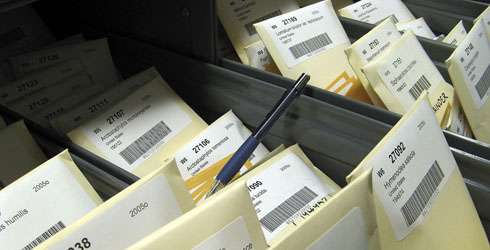Packages of plant material in cold storage. Better use of genetic material stored in seed banks could help provide a practical solution to future food shortages, according to scientists. Credit: Johnson RC, Western Regional Plant Introduction Station.
Better use of the world's seed banks could help provide a practical solution to future food shortages, according to an article in Nature, co-authored by a Natural History Museum scientist.
The breadth of plant biodiversity opens the possibility of domesticating new species or introducing new genetic material into crop plants, according to Dr Sandra Knapp, from the Museum, but we need to focus on using what we have already collected first.
There are more than 300,000 species of flowering plants but we generally use fewer than a dozen for food.
Over the next 25 years food availability needs to double and we will fail to meet that demand if we continue to use such a small fraction of our plant diversity, the authors of the study claim.
Food production systems are already struggling in the face of increasing demand, climate change, soil degradation, and water and land shortages.
Wild plants to the rescue
The seeds of hundreds of crop species and hundreds of thousands of 'primitive' varieties, as well as the wild relatives of crop species and modern varieties no longer in use, are stored in more than 1,700 seed banks worldwide.
Knapp, a botanist and co-author of the Nature article, says that although seeds and tissue cultures in gene banks are well preserved they have not been 'used to their full potential in plant breeding'.
The cost of bring these valuable collections into use would be 'astonishingly low', compared with the amount spent sequencing the human genome or maintaining other large scientific infrastructures.
'The Museum's work on the identities and evolutionary relationships of crop wild relatives is critical to the success of these efforts,' Knapp says. 'Our work in discovering and describing plant species related to crops gives essential information about the traits of these wild species and the environments where they grow.
'This helps scientists target their collecting efforts on areas of particular interest and enables us to better understand collections already held in gene banks.
'Recognising the evolutionary relationships between wild species and crop plants allows us identify species that might be useful for interbreeding.'
Knapp adds that areas on the edge of wild plants' geographical ranges are of particular importance for crop breeding research in the face of climate change as they are 'often areas where plants face special environmental challenges'.
Journal information: Nature
Provided by Natural History Museum





















